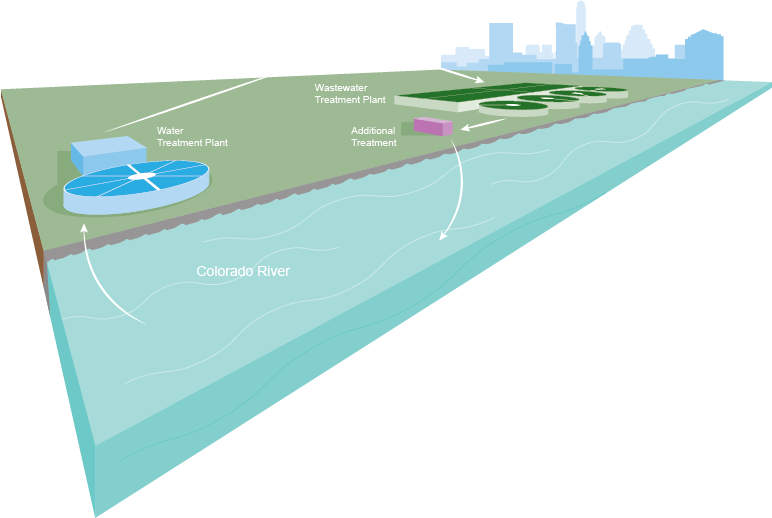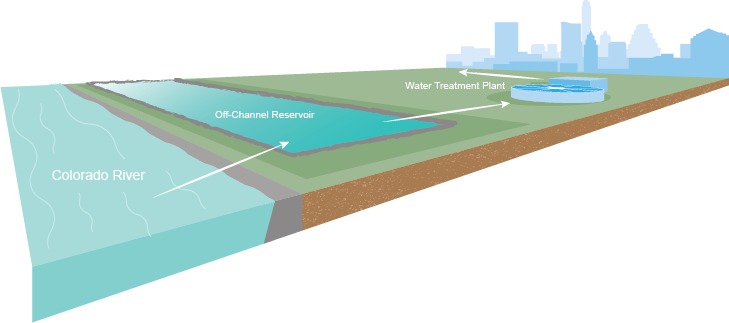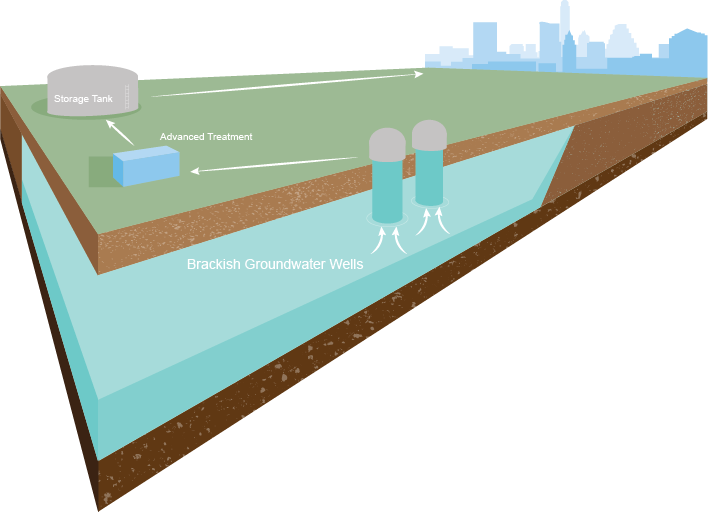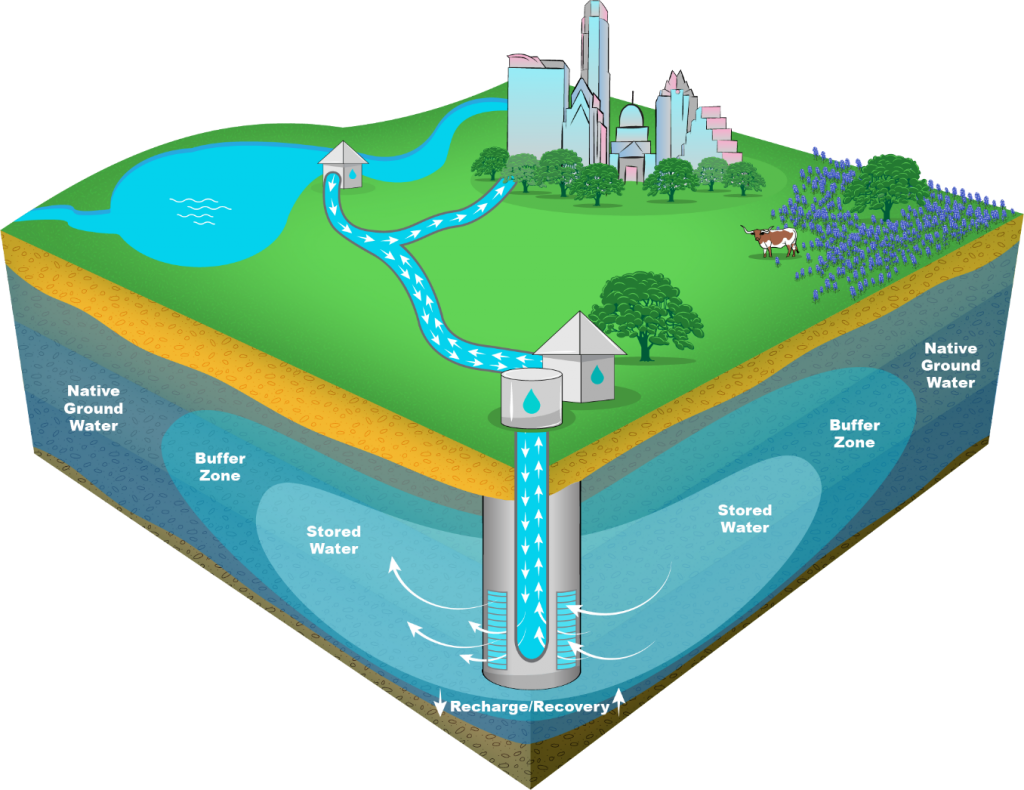One of the key drivers of the Water Forward Plan was the 2008-2016 drought, when inflows of water and combined storage volumes in Lakes Travis and Buchanan were at historic lows. The major water supply projects included in the plan are largely to augment Austin’s access to water during drought when core surface water supplies are limited.
Aquifer Storage and Recovery (ASR) is a water supply strategy to store available water for recovery and use when we need it most. In 2021, Austin Water began a study to determine if aquifers in our region could be used for an ASR project in the future.
Aquifer Storage and Recovery, also called ASR, is a water storage strategy in which water is stored in an aquifer during wetter periods and recovered at a later date. Storing water underground can improve drought preparedness in the same way storing water in a reservoir does, while eliminating the water loss due to evaporation that occurs in open above-ground reservoirs. To learn more about Austin’s ASR project, click on the ASR tab.
.png)
Indirect Potable Reuse, also called IPR, is included in Water Forward as an emergency water supply strategy for infrequent use during only the most severe drought situations. IPR would convey highly treated reclaimed water from a wastewater plant to Lady Bird Lake so it could be diverted for treatment to drinking water standards. The strategy is combined with the Capture Local Inflows to Lady Bird Lake strategy, which would use portions of the IPR infrastructure outside of severe drought conditions to capture local inflows from Barton Springs and other creeks. As included in Water Forward, these strategies are planned to be online by 2040.

Off-Channel Reservoir, or OCR, is a water storage strategy where a reservoir is constructed away from the main stem river and is filled by pumping water from the main river channel to the reservoir. This allows water to be stored during wetter times and used to supply drinking water during dry times. As included in Water Forward, this strategy will be online by 2070.

Brackish Groundwater Desalination is a strategy where salty groundwater is treated to drinking water standards. This strategy is a longer-term water supply strategy in Water Forward, with implementation by 2070.

About Aquifer Storage and Recovery
When water supplies are plentiful, an Aquifer Storage and Recovery system will store available drinking water in a natural aquifer underground. When regular water supplies become low during a drought or other emergency, the stored water is pumped out of the aquifer and tested and treated to meet Austin’s drinking water standards before it’s distributed to customers.

Project Background
From 2008-2016, a historic drought hit Central Texas, reducing water in the highland lakes to historically low levels. In response, Austin Water created Water Forward, a plan to guide Austin’s water future for the next 100 years. The Austin City Council-approved Water Forward plan includes conservation, reuse, and water supply strategies to ensure a diversified, sustainable, and resilient water future for Austin. Aquifer Storage and Recovery is one of the water supply projects included in Water Forward. An ASR system will help make Austin’s water supply more resilient through climate change and droughts and can provide a second source of water during emergencies, like freeze events or flooding. An ASR system will store water available under the City’s existing water rights, allowing Austin to maximize local water resources.
Project Update – April 2025
Austin Water began a scientific study in 2022 for its ASR project. After completing a comprehensive screening evaluation of aquifers within an eight-county area, Austin Water narrowed its study area to Travis, Bastrop and Lee Counties. Additional spatial analysis was then conducted to select a focus area for field testing and further study for the project.
After careful scientific study, the Carrizo-Wilcox Aquifer in Bastrop County was identified as the focus area because it has favorable hydrogeology, is closer to the existing system infrastructure, and is in an area where water can be stored deep in the aquifer well and below levels of local wells.
Travis County was thoroughly evaluated but was not identified as the focus area because the hydrogeology is less favorable than Bastrop County, resulting in lower water storage capacity.
Austin Water is working with stakeholders in Bastrop County to provide updates about the study results, to discuss safeguards for the aquifer and local communities, and to learn about desired community benefits in Bastrop County.
What's Next?
Austin Water wants to work with stakeholders to develop a project that can provide regional benefits. As Central Texas continues to experience rapid population growth and increasing water demands, innovative strategies like ASR will be critical to securing the state’s water future.
The next phase of the project will include exploratory drilling and field testing. In this phase groundwater samples and core samples will be tested in a lab to understand baseline geochemistry and will be tested with Austin Water drinking water to observe and document any interactions. Based on these results, appropriate treatment processes can be designed for the next project phase to prevent adverse reactions and protect the health of the aquifer. Austin Water will provide results and seek feedback.
Submit ASR feedback on Speak Up Austin
ASR Resources
Check out the links below to learn more and get involved!
Frequently Asked Questions
- Will the Aquifer Storage and Recovery (ASR) project capture flood water?
-
No, Austin’s ASR project is not planned to capture flood waters. The ASR project will store drinking water from Austin's core supply source, the Colorado River and Highland Lakes. An ASR project for flood mitigation is not feasible due to infrastructure and storage requirements as well as cost.
- How will Austin protect the water that is stored in the ASR?
-
It is a priority for Austin Water to choose a location for the project that will allow us to protect the water that we store. AW will have control of the land above our stored water, but due to the early stage of the project, we have not yet identified specific strategies to achieve that. Other ASR projects, for example, have purchased the land above their stored water to protect it, and leased the land back to farmers or ranchers. Additionally, Texas Commission on Environmental Quality (TCEQ) requirements for ASR state that ASR projects must be able to maintain control over their stored water.
- Is ASR a project to develop groundwater?
-
No, Austin’s ASR project will not take native groundwater. The project will store Austin’s existing water supplies for later use. Austin’s ASR project will not take out more volume of water than it puts into the aquifer, per state requirements from the Texas Commission on Environmental Quality.
- Who is paying for this?
-
Austin Water will pay for this project over a number of years using strategies that allow us to finance large projects while keeping customer rates affordable. Austin Water’s debt management strategies have made it possible to address two competing needs – spending on improvements infrastructure for dependable water service while keeping water rates down and affordable for customers of all incomes. Securing near-zero percent interest loans also helps Austin Water fund major infrastructure projects at a tremendous cost savings for the utility and its customers.
- Why are you considering Bastrop County?
-
Austin has completed a comprehensive evaluation of numerous aquifers within the region, across eight counties. The Carrizo-Wilcox, which is successfully used for ASR in Bexar County, was determined to be able to meet project goals and provide the storage capacity scale that Austin Water needs.
After careful scientific study, the Carrizo-Wilcox Aquifer in Bastrop County was identified as the focus area because it has favorable hydrogeology, is closer to the existing system infrastructure, and is in an area where water can be stored deep in the aquifer well and below levels of local wells. An area in Bastrop County several miles south of Paige, TX is the current focus area for the next phase of field testing.
Travis County was thoroughly evaluated but was not identified as the focus area because the hydrogeology is less favorable than Bastrop County, resulting in lower water storage capacity.
For more information relating to aquifers and groundwater please click here.
- What type of water will be stored in the ASR project?
-
Austin’s ASR project is planned to store water from Austin’s drinking water system. Water for ASR will be treated before it goes in the ground to ensure compatibility with the aquifer and existing groundwater. When ASR water is recovered, it will be treated to be fully compatible with AW’s existing drinking water quality.
- Will water quality in the aquifer be impacted?
-
In the next stages of ASR development, we will perform field testing to gather core samples and native groundwater samples and test those in a laboratory setting to understand baseline geochemistry and compatibility with Austin Water drinking water. This will allow design of appropriate treatment processes to prevent adverse water quality reactions and protect the health of the aquifer. After this step, Austin Water will develop a small-scale ASR pilot project to further characterize how Austin’s drinking water that will be stored in the ASR may interact with native groundwater. Extensive water quality testing will be done before a decision is made to move to each subsequent phase of the project.
- What effect will the ASR project have on neighboring wells?
-
Austin Water will seek to operate the ASR wells in a manner that minimizes local well impacts. We understand from other ASR projects that overall water levels for adjacent wells typically increase when water is being added to the ASR and decrease when ASR water is being withdrawn. Austin’s ASR project will not withdraw (or recover) more water than was stored. Austin Water will improve and lower wells where necessary.
- How much land will be needed for the ASR project?
-
The amount of land needed for an ASR project is based on location and aquifer characteristics. We currently estimate that up to approximately 7,000 acres will be needed for the wellfield and a half mile buffer. Only about 200 acres of that amount will be needed for wells, facilities, and aboveground improvements.
To legally protect the stored water, the land above the storage zone must be protected from pumping. Landowners will be compensated for purchase or lease of land and may remain on the land to continue local farming and ranching operations.
- How much water will be stored in the ASR now and in future years?
-
Austin Water’s 2024 Water Forward plan has a goal of storing 60,000 acre-feet of water in the planned ASR project by 2040 and 300,000 acre-feet by 2080.
- Will ASR poison the water in the aquifer?
-
No, the success of the ASR project is fundamentally tied to the protection of the Carrizo-Wilcox Aquifer system. The area’s drinking water will rely on the health of the aquifer once this project is built. If this project does not protect water quality for the region, then it does not work. The project includes substantial time for field testing and piloting to develop an understanding of water
chemistry in the aquifer and design appropriate treatment processes. The next phase of testing (approximately three years) would involve lab testing of native groundwater interactions with Austin’s drinking water, which is sourced from Lakes Austin and Travis.

